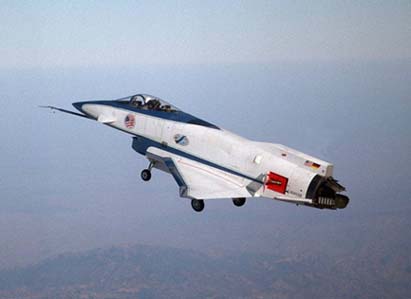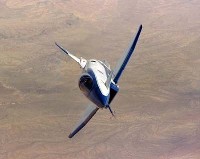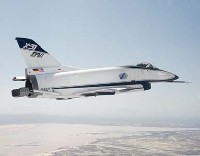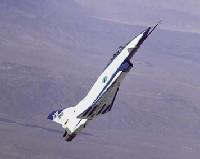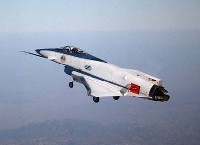|
Global Aircraft -- X-31 EFMD
Aviation Center
US Attack
US Bombers
US Cargo
US Fighters
US Helicopters
US Patrol/Pursuit
US Reconnaissance
US Tankers
US Trainers
US UAV's
US X Planes
Orbiter Vehicles
WWI Aircraft
WWII Aircraft
Airbus
Antonov
Boeing
Dassault
Ilyushin
Kamov
MiG
Mil
Saab
Sukhoi
Tupolev
Yakovlev
Joint/Rest of World
Entertainment Center
Members Center
New Technologies
Contact Us
Extra Navigation
GAC Engine
X-31 EFMD Specifications
X-31 EFMD Achievements
X-31 EFMD Features
Three thrust vectoring paddles made of graphite epoxy and mounted on the X-31's aft fuselage were directed into the engine exhaust plume to provide control in pitch (up and down) and yaw (right and left) to improve maneuverability. The paddles sustained temperatures of up to 1,500 degrees centigrade for extended periods of time. In addition, the X-31s was configured with movable forward canards, wing control surfaces, and fixed aft strakes. The canards are small wing-like structures located just aft of the nose, set on a line parallel to the wing between the nose and the leading edge of the wing. Source: http://www.dfrc.nasa.gov
X-31 EFMD Background
The X-31 flight test program was conducted by an international test organization (ITO) managed by the Advanced Research Projects Office (ARPA), known as the Defense Advanced Research Projects Office (DARPA) before March 1993. The ITO included the U.S. Navy and U.S. Air Force, Rockwell Aerospace, the Federal Republic of Germany, Daimler-Benz (formerly Messerschmitt-Bolkow-Blohm and Deutsche Aerospace), and NASA. Gary Trippensee was the ITO director and NASA Project Manager. Pilots came from participating organizations. The X-31 program demonstrated the value of using thrust vectoring (directing engine exhaust flow) coupled with advanced flight control systems, to provide controlled flight to very high angles of attack. The result was a significant advantage over conventional fighters in a close-in combat situation. Source: http://www.dfrc.nasa.gov
| ||||||||||||||||||||||||||||||||||||||
